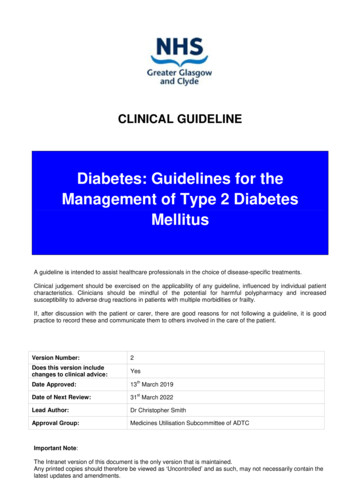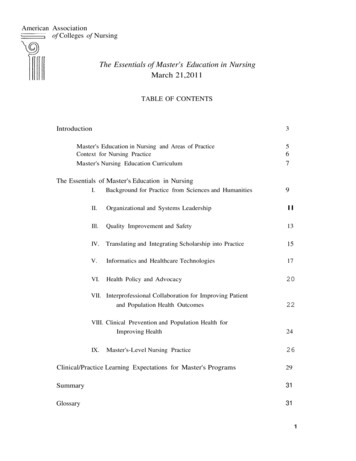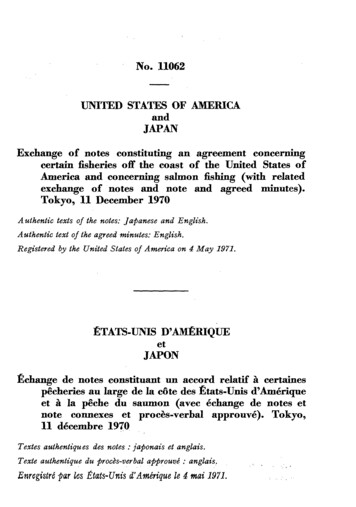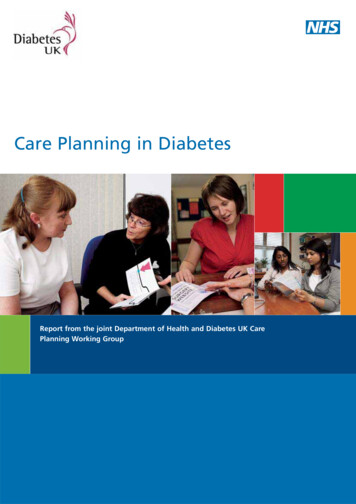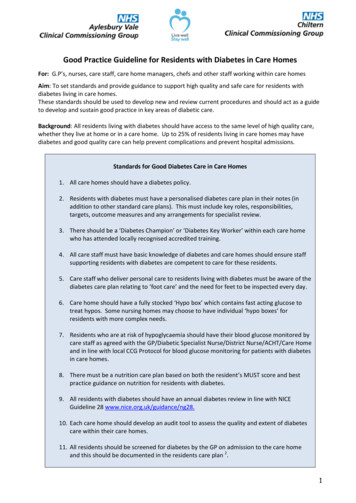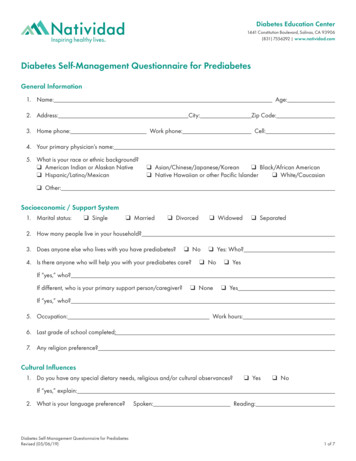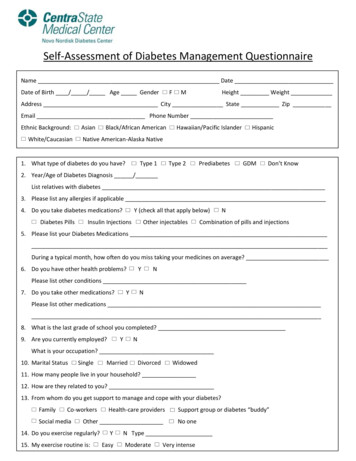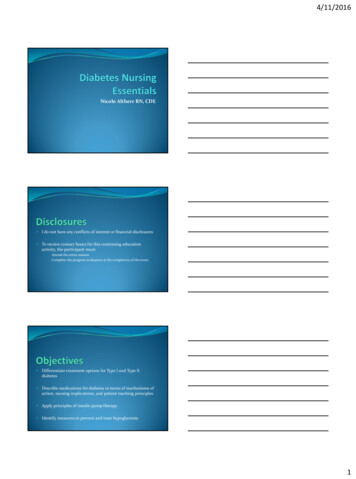
Transcription
4/11/2016Nicole Altherr RN, CDE I do not have any conflicts of interest or financial disclosures To receive contact hours for this continuing educationactivity, the participant must: Attend the entire sessionComplete the program evaluation at the completion of the event. Differentiate treatment options for Type I and Type IIdiabetes Describe medications for diabetes in terms of mechanisms ofaction, nursing implications, and patient teaching principles Apply principles of insulin pump therapy Identify measures to prevent and treat hypoglycemia1
4/11/2016A NEW FOCUS ON DIABETES CAREDefinition: Diabetes Mellitus is a group of diseases characterized by high blood glucoselevels that result from defects in the body’s ability to produce and/or use insulin.Diabetes is a highly prevalent, debilitating and costly disease that increases the risk forother serious health conditions (e.g. heart disease, stroke, kidney disease, blindness, andlower-extremity amputations).Statistics: Approximately 26 million children and adults in the US (8.3% of thepopulation) have diabetes. Wichita County has a prevalence of 11.9% of the populationwith diabetes, which is higher than the state average of 9.7%. At United Regional, everyday at least 30% of inpatients are being treated for abnormal glucose levels.By 2030, it is estimated that 552 million people worldwide will have diabetes. Theprevalence of diabetes worldwide increased dramatically in children between 2000 and2009. Children with Type 1 DM had a 21% increase between these years, with a 30%increase in children with Type 2 DM (Pediatric Academic Society meeting, Vancouver,Canada, 2014). These dramatic increases mean of lifetime of difficult and costlytreatment for the patient, caregivers, and health organizations.Implications: All nurses, whether in the acute care, outpatient, long term care, school, orhome health, or medical office setting, etc., have a role in the healthcare system to helpthe patient manage their diabetes. The goal of this course is to help the nurse tounderstand current guidelines and best practices in order to provide quality nursing carethat is consistent with ADA guidelines, but individualized based on an assessment of thepatient’s specific needs.INSULIN OVERVIEWInsulin classifications:1) basal (long-acting), examples: Lantus and Levemir2) bolus (rapid-acting), examples: Novolog, Humalog, Apidra(short-acting), example: Regular insulin (Humulin R or Novolin R)3) Intermediate, example: NPH (Humulin NPH or Novolin NPH)4) Mixed Insulin, example: Novolog Mix 70/30; Humalog Mix 75/25;Humalog Mix 50/50Novolin 70/30 BASAL (slow release)—1. Provides “relatively” flat 24 hour coverage.2. Used to control blood sugars between meals and overnight.3. Can be dosed once or twice daily (if b.i.d., space 12 hours apart).4. Important to take basal insulin at consistent times.5. Does not have to be “timed” to food intake. Not intended to “cover” foodintake. (Basal insulin is given, even if the patient is NPO)6. Bedtime snacks are not required with Levemir or Lantus (**if the dose iscorrect). Should never have to “eat up” to insulin dose to prevent lowBlood sugar.7. Do not mix Levemir or Lantus with any other insulin in the same syringe. BOLUS (fast release)—Used for two purposes—mealtime and correction1) Mealtime insulin (prandial) used to control BG related to food intake.--Patient must be eating at least 50% of the carbs on their plate.--Should be given at the start of the meal or immediately after they haveeaten (if you are not sure if the patient will eat 50% of the carbs). Do notgive if greater than 30 minutes has passed since completion of the meal.2) Correction insulin (sliding scale). This insulin corrects a high glucose(above target) when blood sugars are checked before meals or at bedtime.--Correction insulin should be given regardless of appetite/intake or NPOstatus.--The duration of Novolog/Humalog is 4 hours. Do not administeradditional correction sooner than 4 hours apart. The duration of Regular is 6hours. Do not administer additional correction sooner than 6 hours apart.(This is considered “stacking” insulin, and can lead to hypoglycemia).--If the physician/provider orders 2 hour postprandial BG checks, thesechecks are timed from the start of the meal and are used to evaluate theeffectiveness of the mealtime insulin dose and should not be corrected withadditional insulin.--It is NEVER necessary to give someone food or snacks when administeringcorrection insulin. Giving food with “correction” insulin defeats thepurpose of the correction (because BG is already too high.)--The FSBG must be checked within 30” prior to a meal. Do Not check ifpatient has already started eating.2
4/11/2016--Mealtime and correction should be given as one dose (to avoid 2 sticks!) NPH (intermediate) (Humulin is Eli Lilly/Novolin is Novo Nordisk)--administered once or twice daily.--morning dose is administered with breakfast.--evening dose is given either with supper meal or bedtime--Begins working (onset) in approximately 1.5 hours, but peak and durationare variable. Peak--2 to 12 hours. Duration—14-24 hours--some patients on NPH may benefit from h.s. snack (if NPH is taken atsupper, instead of bedtime)--roll vial briskly 10 times before drawing into syringe Mixed insulin—example Novolog Mix 70/30 (70% intermediate/30% rapid)--to be administered with AM and PM meals only. Should never be given atother times.--when given with supper meal, this insulin peaks around 2 a.m., therefore thispatient requires an h.s. snack to prevent nocturnal hypoglycemia.--roll vial briskly 10 times before drawing into syringe.GENERAL REMINDERS ABOUT INSULIN:1) Insulin injection sites must be rotated to prevent scar tissue. Try to keep injections about2 inches apart. Never aspirate after administering the insulin and avoid massaging orrubbing the injection site.2) Keep insulin needle (whether using a pen device or syringe) under the skin after theinjection for 6-10 seconds to help prevent insulin from leaking from the site.3) Once opened, a bottle of insulin can be stored at room temperature. (Approx. 30 days)4) Unopened vials of insulin or insulin pens should be stored in the refrigerator until theyare opened for use.5) Once a pen device goes into use, do NOT return to the refrigerator. Leave at roomtemperature. Insulin pen device should be “primed” before each use.KEY NURSING POINTS RELATED TO FINGERSTICK BLOOD GLUCOSE CHECKS:ADA Recommended Targets for Blood Sugar Control in Adults with DiabetesNormalTargetWhen to take ActionBefore eating 100mg/dl80-130mg/dlIf 70 or greater than 150mg/dl**A pre-meal BG check needs to be done when the patient has not eaten carb-containing food ordrink for 4 hours. (Carb-free snacks allowed, ex. Nuts, cheese, meat) Therefore:1.)Encourage the patient to NOT eat sooner than 4 hours between meals in order for BG to beaccurate. Consistent carbs at consistent times is beneficial to blood sugar control.2.)Bedtime blood sugar must not be checked sooner than 4 hours after the patient has eatenhis/her dinner.TREATMENT OF HYPOGLYCEMIAADA guideline is to treat blood sugar less than 70mg/dl in diabetes patients.Key Points for Nursing: Assess for symptoms—patient might be sweaty, shaky, irritable; havedecreased level of consciousness, headache, hunger, visual changes.Check BG right away (if possible!)Rule of 15—15 grams of fast-acting sugar, then retest in 15 minutes. If BG isless than 50mg/dl, will require 30 grams of fast-acting sugar. Recheck in 15minutes. Continue to treat and re-test until BG is greater than 70mg/dl. Once70mg/dl or above, give snack or meal that contains protein and fat to helpstabilize blood sugar.Try to determine precipitating factor in order to prevent future hypoglycemia.Is the hypoglycemia part of a pattern that requires a medication adjustment?Follow your facility’s policy for documentation of the event.**15 gram treatment options—4 ounces of juice (1/2 cup); 4 ounces of regular soda; 1tablespoon jam/jelly/honey/sugar/etc.; 1 cup of skim milk; 4 glucose tablets.**A “meal tray” is NOT treatment for low blood sugar. Remember to treat firstaccording to Rule of 15 before introducing fat or protein into the digestive process.3
4/11/2016Tandem T slimOne Touch Animas PingMedtronic Minimed RevelInsulet OmnipodAccu Check SpiritDexcom G5Tandem T slim G4Medtronic 530G withEnlite SensorDexcom G5 MobileOne Touch Animas VibeINSULIN PUMP THERAPYInsulin pump therapy was first introduced to patients in 1978. Pump therapy has changedconsiderably since then. Pumps are smaller, easier to use and many more patients use thepump than ever before.Health1.2.3.4.5.6.Professionals recommend pumps for patients with:Sub-optimal glycemic controlDawn Phenomenon, with elevated fasting blood sugarsFrequent or severe hypoglycemia or hypoglycemia unawarenessNight time hypoglycemiaPost-meal hyperglycemiaWidely fluctuating blood sugars (“brittle” diabetes), even in those with a“good”A1C7. Insulin requirement of less than 30 units per day or large doses requiring 100units per day8. Frequent travel9. Variable work schedule (especially shift work)10. Intensive exercise or for athletes11. Reminders to bolus for carbs and test blood glucose (alarm reminders)12. Tracking insulin doses, carbs, glucose levels, and other information critical toglucose control. (Pump History review capability)13. Preventing, delaying or reversing complications14. Improving control during growth and puberty in children and adolescents15. Managing gastroparesis with its erratic food absorption16. Preparing for conception or during pregnancy17. Frequent ketoacidosis18. Frequent hospitalizations for diabetes19. Improved quality of life due to increased flexibility (examples, convenience, lessfrequent “sticks”, improved matching of insulin delivery to body’s variable needs,assistance with carb calculations, etc.)4
4/11/2016Purpose of Insulin therapy:Insulin delivery must mimic the way the body naturally works. In non-diabetes patients,beta cells release precise amounts of insulin to cover basic needs:1) background insulin is released as a steady flow to control bloodsugars 24/7 by directing the uptake of glucose as fuel.2) Short bursts of insulin to match the carbohydrate content of foodeaten.Purpose of MDI or pump therapy is to provide “background control” through long actinginsulin by injection (Lantus, Levemir or intermediate NPH) or basal settings programmedin the pump. Also, to provide boluses (quick release of insulin, example Novolog,Humalog , Apidra or Regular) for food consumed or for correction to lower a high bloodsugar.Some disadvantages of Insulin Injections and advantages of Pump therapy:1. Inconvenience of MDI (requires an insulin bottle and syringe/ or pen device beavailable at all times, even at restaurants).*More convenient: Pump is attached to the body and newer models are verydiscrete.2. Lack of precision with MDI (lowest dose is ½ unit using a pediatric syringe orpen).* More precision with Pump: can deliver insulin in increments as small as 0.025(twenty five thousandths) of a unit.3. Variable daily activity levels are hard to control with 1 or 2 injections of a longacting insulin. Once the injection is given, it cannot be “taken back” and willcontinue to work until it has worn off.*Basal delivery from a pump can be more easily matched to the changingbackground needs of those who have Dawn’s Phenomenon, who work differentshifts, who engage in physical activity at different times, etc. The pump can besuspended, if needed.4. Unusual circumstances such as illness, periods of stress, steroid therapy, etc. areharder to control with injections.*Pump has a “temporary” Basal feature for increases or decreases to thebackground basal settings.1. Patients often “tire” of taking numerous injections daily and may skip injections*Pump sites are typically changed every 1-3 days (depending on the total dose ofinsulin required by the patient) Patient needs to check BG 4 times a day for bestresults and enter carbs, and the pump will deliver the dose needed based on theICR and ISF programmed in the pump.2. Tendency not to take additional injections between meals for snacks consumed.*Can easily program additional carbs consumed into the pump, which willdeliver the additional insulin for the snacks, etc.3. Easy to “forget” if injections were given or not.*Pump records a “history” of boluses for patients to review.4. Excess bolus insulin and insulin stacking with MDI, leading to hypoglycemia.*Pump features such as the ICR , ISF and IOB to help deliver precise carb bolusamounts, and keeps track of active insulin from previous boluses when a newbolus is attempted to prevent stacking of insulin.5
4/11/2016DRAWBACKS TO PUMPING: Patient must be motivated (learning curve) and be ableand willing to check blood sugars at least 4 times a day and count carbs.1. It is a mechanical device that depends on several components to work properly.Though not common, there are instances of pump failures.2. Attachment to a “device” may seem inconvenient or embarrassing.3. Ketoacidosis remains a higher risk for a Type 1 insulin pump wearer (the pumponly uses fast acting insulin. The longer-action of a basal injection such asLevemir or Lantus can help protect against ketoacidosis. If the pump delivery isinterrupted for any reason, the blood sugar can start to rise as the insulin levelsfalls (the duration of Novolog and Humalog being only 4 hours)As the insulin levels fall and glucose is no longer available for fuel, the body willstart to burn fat for energy. As more and more fat is consumed, production ofacid by-products (ketones) build up in the blood stream, leading to a dangerousand life-threatening condition called Diabetic Ketoacidosis.4.5.Site issues—infection and irritation is a greater risk with a pump because aninfusion set typically remains in place for 2-3 days.Expense of the pump and ongoing supplies.6. Many Healthcar
in the pump. A lso, to provide boluses (quick release of insulin, example Novolog, Humalog , Apidra or Regular) for food consumed or for correction to lower a high blood sugar. Some disadvantages of Insulin Injections and advantages of Pump therapy : 1. Inconvenie nce of MDI (requires an insulin bottle and syringe/ or pen device be
